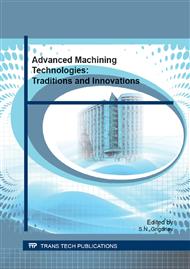[1]
M.A. Volosova, V.D. Gurin. Influence of vacuum-plasma nitride coatings on contact processes and a mechanism of wear of working surfaces of high-speed steel cutting tool at interrupted cutting. Journal of Friction and Wear, (2013).
DOI: 10.3103/s1068366613030148
Google Scholar
[2]
A.A. Vereschaka, S.N. Grigoriev, A.S. Vereschaka, A. Yu. Popov, A.D. Batako Nanoscale multilayered composite coatings for cutting tools operating under heavy cutting conditions. Procedia CIRP (2014).
DOI: 10.1016/j.procir.2014.03.070
Google Scholar
[3]
S.N. Grigoriev, S.V. Fedorov, M.D. Pavlov, A.A. Okun'kova, So Ye. M. Complex surface modification of carbide tool by Nb + Hf + Ti alloying followed by hardfacing (Ti + Al)N. Journal of Friction and Wea, (2013).
DOI: 10.3103/s1068366613010054
Google Scholar
[4]
A.S. Vereschaka, S.N. Grigoriev, E.S. Sotova, A.A. Vereschaka/ Improving the efficiency of the cutting tools made of mixed ceramics by applying modifying nano-scale multilayered coatings. Advanced Materials Research (2013).
DOI: 10.4028/www.scientific.net/amr.712-715.391
Google Scholar
[5]
C.B. Zou, C.Z. Huang, B. Zou, Y.H. Fei, H.L. Liu et al. Establishment of the low defect ceramic cutting tool database. Advances in machining and manufacturing technology XII Book Series: Key Engineering Materials (2014).
DOI: 10.4028/www.scientific.net/kem.589-590.357
Google Scholar
[6]
L.A. Chernozatonskii, V.P. Val'chuk, A.B. Ormont, N.A. Kiselev, O.I. Lebedev, D.N. Zakharov. Synthesis and structure investigations of alloys with fullerene and nanotube inclusions. Carbon (1997) 749-753.
DOI: 10.1016/s0008-6223(97)00027-4
Google Scholar
[7]
V.Y. Fominskii, R.I. Romanov, S.N. Grigorev, V.N. Nevolin. Effect of the pulsed laser deposition conditions on the tribological properties of thin-film nanostructured coatings based on molybdenum diselenide and carbon. Technical Physics. The Russian Journal of Applied Physics (2012).
DOI: 10.1134/s1063784212040081
Google Scholar
[8]
S.V. Fedorov, M.D. Pavlov, A.A. Okunkova. Effect of structural and phase transformations in alloyed subsurface layer of hard-alloy tools on their wear resistance during cutting of high temperature alloys. Journal of friction and wear (2013).
DOI: 10.3103/s1068366613030069
Google Scholar
[9]
A.S. Ponomarev, E.N. Sosenushkin, V.N. Klimov. Effect of process features of pressure treatment on the microstructure and quality of parts of pipeline fittings from high-strength cast iron. Metal Science and Heat Treatment (2012).
DOI: 10.1007/s11041-012-9450-2
Google Scholar
[10]
Rogachev A.S., Mukasyan A.S. Combustion for material synthesis / NY, CRC Press Reference, (2014). p.424.
Google Scholar
[11]
Zhang, YM, Gu, Y, Chen, JT Boundary element analysis of the thermal behaviour in thin-coated cutting tools / Engineering analysis with boundary elements, (2010), Vol. 34, pp.775-784.
DOI: 10.1016/j.enganabound.2010.03.014
Google Scholar
[12]
O.V. Sobol, A.A. Andreev, S.N. Grigoriev, M.A. Volosova, V.F. Gorban. Vacuum-arc multilayer nanostructured TiN/Ti coatings: structure, stress state, properties. Metal Science and Heat Treatment (2012).
DOI: 10.1007/s11041-012-9451-1
Google Scholar
[13]
G.P. Glazunov, A.A. Andreev, O.V. Sobol et al. The effect of nitrogen pressure during vacuum-arc TiN coatings deposition on the erosoin resistance in plasma of magnetron type discharges. Problems of atomic science and technology (2014).
Google Scholar
[14]
S.N. Grigoriev, A.M. Gurin, O.B. Kovalev. Modelling of Thermocapillary Convection within the Molten Pool with the Dispersed Impurity at Laser Surface Hardening of Materials. Metallofizika i noveishie tekhnologii (2013).
Google Scholar
[15]
A.A. Andreev, V.M. Beresnev, M.A. Volosova et al. Tribological characteristics of nanocomposite vacuum-plasma Ti-Hf, Ti-Hf-N, and Ti-Hf-Si-N coatings. Journal of friction and wear (2013).
DOI: 10.3103/s1068366613030033
Google Scholar
[16]
O.V. Sobol, A.A. Andreev, S.N. Grigoriev et al. The Effect of Constant Negative Bias Potential on the Structure, Substructure and Stressedly Deformed State of the TiN Coatings. Metallofizika i noveishie tekhnologii (2013).
Google Scholar
[17]
E. Grigore, C. Ruset, K.T. Short, D. Hoeft, H. Dong, X.Y. Li, T. Bell. In situ investigation of the internal stress within the nc-Ti2N/nc-TiN nanocomposite coatings produced by a combined magnetron sputtering and ion implantation method. Surf. Coat. Technol (2005).
DOI: 10.1016/j.surfcoat.2005.02.118
Google Scholar
[18]
S.N. Grigoriev, V.A. Sinopalnikov, M.V. Tereshin, V.D. Gurin. Control of parameters of the cutting process on the basis of diagnostics of the machine tool and workpiece. Measurement Techniques (2012).
DOI: 10.1007/s11018-012-9999-6
Google Scholar
[19]
S.N. Grigoriev, V.D. Gurin, M.A. Volosova, N.Y. Cherkasova. Development of residual cutting tool life prediction algorithm by processing on CNC machine tool. Materialwissenschaft und Werkstofftechnik (2013).
DOI: 10.1002/mawe.201300068
Google Scholar


